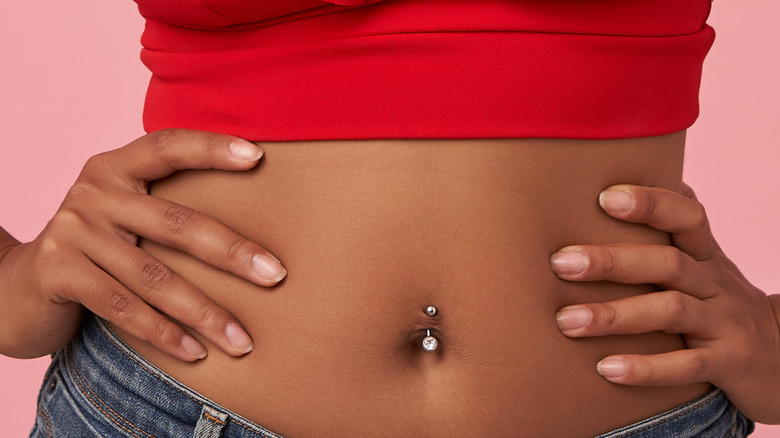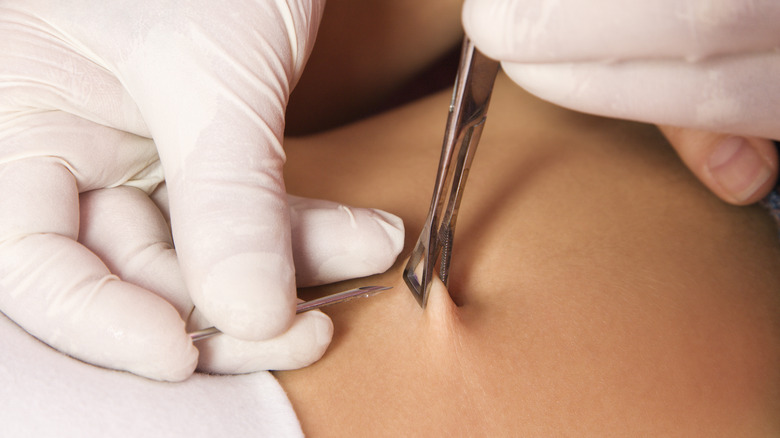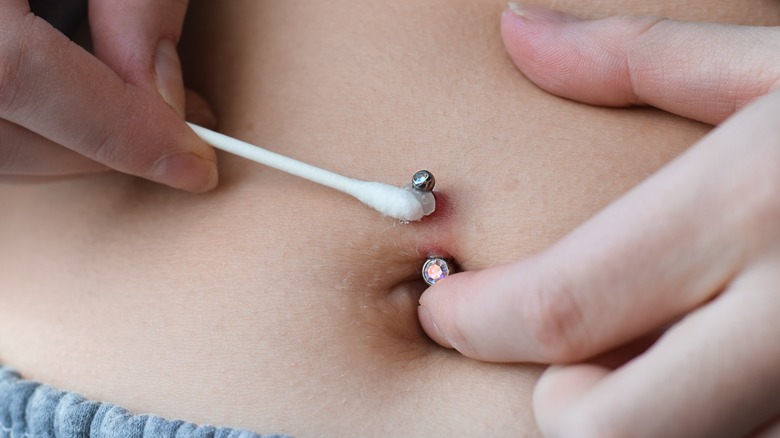How Long Does It Take For A Belly Button Piercing To Heal?
For some, piercings are a part of their culture. For others, body jewelry could be a sign of rebellion, a fashion statement, or a form of healing, per Lulus Body Jewelry. Whatever the reason, piercings are a popular form of body modification, and belly button piercings are one of them. Belly button piercings are also called navel piercings, and they are done about half to 1 inch away from your belly button. According to Painful Pleasures, this distance between the pierced area and the belly button allows the jewelry to hang right on top of the navel. Belly button piercings have been part of several cultures but they became especially mainstream in the late '90s and '00s, with musicians and video vixens sporting them while wearing crop tops and low-waisted jeans. With the resurgence of Y2K fashion, it's no wonder belly button piercings are even more popular in recent times.
Belly button piercings can be a fun way to express yourself and are pretty easy to hide if you ever need to. However, as far as healing goes, it can take up to a year, according to the experts at Healthline.
How is a belly button piercing done?
Urban Body Jewelry describes belly button piercings as "anatomy-dependent" procedures. This means some navels, including outies, can get pierced, while some surgically reconstructed navels may not be a fit for one. Before piercing, your piercer — who should be reputable, experienced, and licensed — will discuss the requirements and aftercare of the piercing with you. You'll choose your jewelry, usually a 14-gauge barbell, and the piercer will sanitize the area with some alcohol.
The piercer will also mark the area above or below the belly button where the piercing needle will go in and out. That said, you might need to look at the marked area in a mirror while standing and decide if the location of the piercing is okay for you. Once you give the go-ahead, your piercer will clamp the points or choose to do it freehand and quickly insert the needle. A receiving tube will follow the needle, and the jewelry will be looped through.
How long does it take to heal?
Belly button piercings usually heal in nine months to a full year and sometimes take even longer, according to Healthline. They are notorious for appearing to have healed within the first four to six weeks following the procedure, but Authority Tattoo warns not to fall for this ruse. The piercing is nowhere near healed at this time and still needs constant aftercare. Speaking of aftercare, belly button piercings are no exception to the general piercing guidelines. After getting your piercing done, you'll have a couple of rules to follow for your new bling to heal completely. One of them is to clean the site with a sterile saline solution and a non-woven gauze or cleaning pad. This will keep your piercing free of infections and ensure it heals in record time.
Another crucial tip is to avoid moving your jewelry around while cleaning, as this can disrupt recently developed tissue and prolong the healing time. Belly button piercings are one of the most difficult to heal, but with good aftercare, WebMD explains that your piercing should be fully healed in approximately one year.
How to know when a belly button piercing is fully healed
While the healing time for belly button piercings can be long, it's all worth it once the site has fully recovered and you can proudly show off your new body jewelry. So how do you know when the piercing is fully healed? "Generally, any tenderness and redness will be completely gone and the piercing channel will no longer be secreting or developing crusties," Cozmo Faris, a professional piercer and teacher for the Association of Professional Piercers (APP), revealed to Byrdie. It's generally best to wait until the healing period is over before removing or changing your piercing jewelry, according to Mayo Clinic. If you're unsure, head to a pro for their opinion. "When you want to change it out, check in with your piercer to see if it's actually ready," Joshua David Harris, a piercer at 108 Studios, told PopSugar. "Don't get impatient and change it too soon! It could cause problems you won't want to deal with in the long run."
Infection is one such problem to watch out for. According to Healthline, a navel piercing infection can often be identified by a rash, redness and swelling around the belly button, or unusual discharge. If you notice these symptoms or any other signs of irritation, your piercing hasn't fully healed, and it's wise to visit your piercer or doctor for proper treatment.



